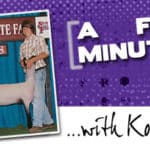
This edition of A Few Minutes is with Tom Strickland. Tommy Strickland lives in Raymond, Mississippi with his wife Nancy. He has four children and five grandchildren that he loves to spend time with and 1 grandchild is already in the show ring. They currently run around 50 Hampshire cross ewes. Tommy is retired from his position with the Mississippi Fair Commission where he worked as the Assistant Director of Livestock Activities for 22 years. As the Assistant Director, Mr. Strickland was in charge of all livestock activities including managing the Dixie National Livestock Show. He has stayed busy since retirement by taking a position with Hinds Community College as an instructor where he teaches Animal Science, Beef Cattle Production, Horse Production, and Livestock Judging. Tommy will be judging the upcoming San Antonio Livestock Exposition.
What was your involvement with the sheep industry growing up?
I actually only ever showed one sheep in 4-H and I was only ten years old. My experience with sheep came more from working as an extension agent. When I started as an agent, the county I was in had about fifty lambs and I became interested in sheep the more I was around them. I started raising them in 1984 purchasing my first group of ewes from Mississippi and purchased one of my first rams from Jimmy Miller.
What genetic base is your ewe flock made up of?
Most of them now go back to the Tank bloodline, which is owned by myself, Frank Poling & Whitaker’s Rockworth Farms. Tank was raised by Achor and is a Leverage Grandson out of a Cabaniss 118 ewe. I also have some McIlrath genetics still in there from the Suffolk cross ewes and a small group of Impact bred ewes that go back to the Packen’ Heat line.
What would you say you’re initial sorts are as you begin to evaluate a class?
Basically, muscle to start off with. I want to them to handle with a good rack, length of top, length of hindsaddle, and be acceptable in their finish. I also like to see a lamb that is real level in their top line.
So what would you call an acceptable fat range?
I would say anywhere from about .18 to .23.
What would you consider an acceptable weight range this time of year?
To me, the most important thing this time of year is that the weight fits the frame size of the lamb. Being February, lambs need to weigh a little heavier; anywhere from 140-160 pounds. Those lambs that weigh 120 to 135 pounds, to me, just haven’t been real productive.
Do you have anything that you strongly prefer not to see out of showmen when they are in the ring?
I really don’t like to see showmen picking them up, but I think this is not much of a problem anymore. I obviously don’t want to see anybody slapping their lamb either. From a fitting standpoint I like to see the leg wool trimmed out and shaped rather than just pulled out to look as big as it can.
What do you look for when sheep are on the move?
I like to see a lamb take a nice long fluid stride and ones that stay together, keeping their front end up and their top level. I like to see them move out sound on their feet and legs and have some natural muscle shape and expression.
What is you’re take on bone size?
I like sheep that have good bone and foot size, but there is a difference between that and shag. It’s important that we are actually paying attention to real bone and foot size, not just hair and wool.
What do you believe the biggest problem is facing the show industry?
We always need to make sure that this project is teaching our kids strong ethics and its important that we encourage the development of those ethics through this project.
Who would you credit with helping to develop your acuity in livestock evaluation?
I would have to first credit my local 4-H agent growing up, Buck Coats, who was my livestock judging coach from the time I was 9 until I was 18. He probably did more training for me than anyone. Also, Dr. Leroy Boyd, my livestock judging coach at Mississippi State University. I also learned a lot from simply watching other judges evaluate shows.
In that case, who are some of the judges you enjoy watching?
There are a lot that I could name, but some of the ones that come to mind are Marvin Ensor, Brad Angus, Keith Berry, and Todd Wise.
What do you wish for kids to learn from the sheep projects?
Well there are the obvious answer like responsibility and discipline, but for me it’s the time with the family working together on a project. If you’re going to be successful at a sheep project it has to be the entire family working on it.
Who’s your favorite musician?
George Strait
If you could go listen to anyone speak, who would it be?
I would have loved to hear Billy Graham speak at some point.
If they made a movie about your life, who would you chose to play you?
Robert Duvall; I think we have similar personalities.
You have judged quite a bit over the years. What are some of the bigger shows you have judged?
I have been blessed with the opportunity to do some great shows. I believe that it is an honor and a privilege to be able to judge them and I feel honored each time I step into the ring. I have judged 15 state fairs and judged in 34 states, including Alaska, over the years. Some of the more prestigious ones would be San Antonio, Aksarben, American Royal, Wisconsin State Fair, California State Fair, and the Ohio State Fair Open Show.
















